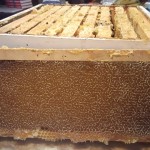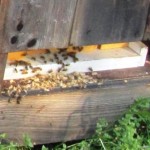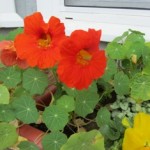Archive for February, 2018
De-Bugging My Honeybee Hive Box of Beetles
I’ve been dealing with a beetle problem in my honeybee hive since fall. When my knowledgeable beekeeper neighbor called to suggest opening the hive, I readily agreed.
The dreaded hive beetle–tinier than a honeybee–can destroy a hive. Its destruction isn’t on the bees themselves, but rather the comb, honey, and pollen. As the population of hive beetle increases and the destruction mounts, the bees will abandon the hive.
Previously, my neighbor had used two types of hive beetle traps in my hive–Beetle Bee-Gone was an all-natural, chemical-free sheet that looked like a fabric softener product for the dryer. We had placed this on top of the frames before closing the hive last fall. The other product was a narrow plastic tray inserted between the frames that held vegetable oil.
We discovered that the sheet worked well, trapping lots of hive beetles. But the frame with oil had no beetles. I dumped it. We checked the brood box–and were excited to see it full of unborn babies.
After harvesting eight frames of honey, we reversed the brood box, scraped away the burr comb, and positioned a super on top of the hive box with empty frames for spring honey. Before closing the hive, we inserted two clean sheets of Beetle Bee-Gone.
Today, the bees are active and out foraging for pollen. Flowers are everywhere and the fruit trees in the neighborhood have broken bud. It remains to be seen if the Bay Area gets any more rain or bitterly cold days ahead. Probably by April 1, I’ll hang the swarm catcher and hope to add a new population of bees to my colony.
______________________________________________________________________________
If you enjoy reading about keeping bees, growing heirloom vegetables and fruits, caring for chickens, or self care for healthy living, check out my Henny Penny Farmette series of cozy mysteries: A BEELINE TO MURDER, THE MURDER OF A QUEEN BEE, and HIVE OF HOMICIDES. Click on the URL below. Also see newest nonfiction for healthy living: RITUALS FOR LIFE.
http://tinyurl.com/ya5vhhpm
Helping the Hummers Refuel
In a single day of darting to and from colorful flowers, the tiny hummingbird consumes nearly half its weight in sugar as it searches for nectar-rich blossoms.
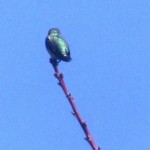
A hummer’s iridescent feathers shimmer as it perches in sunlight at the end of an apricot tree branch
Their wings beat so rapidly, they make a purring sound. Ever industrious, these tiny birds work from dawn to dusk. They are drawn to tubular-shaped flowers or brightly colored ones in shades of red, orange, blue, and pink.
If you want to help the hummers refuel, consider putting flowers on your patio or in your garden that appeal to these little energy burners. Or, better still, plant trees, vines, perennial, and annual plants that will produce the flowers that attract hummers. Choose from the list below.
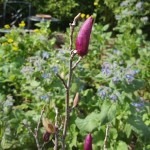
Behind the unfurled buds of the Jane magnolia are the blue blossoms of Borage, an herb frequented by bees, butterflies, and hummers
Annuals: Borage (blue star flower), impatiens, flowering tobacco, petunia, plox, salvia, and snapdragon
Perennials: aloe, alstomeria, bee balm, California fuschia, cardinal flower, columbine, coral bells, foxglove, gladiolus, parrot’s beak, monkey flower, salvia, and sage
Vines: blood red trumpet vine, cape honeysuckle, lonicera (honeysuckle), flame vine, and trumpet creeper
Trees: acacia, chinaberry tree, citrus, coral tree, eucalyptus, silk tree, and tulip tree
______________________________________________________________________
If you enjoy reading about gardening, keeping chickens and bees, and other backyard farming topics, check out my series of cozy mysteries, including A BEELINE TO MURDER, THE MURDER OF A QUEEN BEE, and A HIVE OF HOMICIDES (Kensington Publishing, NY)
A HIVE OF HOMICIDES
Murder of a Queen Bee
A Beeline to Murder
 Facebook
Facebook Goodreads
Goodreads LinkedIn
LinkedIn Meera Lester
Meera Lester Twitter
Twitter




